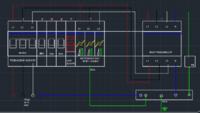Hello
In my opinion, Dehn is the leader when it comes to surge arresters. When it comes to Hager surge arresters (these are the previously used blocks), these are Dehn surge arresters in the Hager packaging.
The price of the arrester depends on the number of modules used, so a 3p arrester will be cheaper than a 4p arrester (the same company).
I assume that it is a switchgear in a single-family house.
The selection of the arrester depends on whether the building is powered by an overhead or cable line (what length), and whether it has a lightning protection system. On this basis, it is possible to estimate the expected level of overvoltage to which an appropriate arrester should be selected.
There are many cheaper alternatives available on the market, but in most cases their quality may be questionable, most often it is the most ordinary varistor. In the case of protectors with replaceable members, this is a more expensive solution, however, it allows the replacement of a single member in the event of damage.
Remember that varistor arrester wears out naturally over time, moreover, a varistor arrester, due to its construction, causes minimal energy consumption (mA current), which increases with the wear of the arrester.
Summing up: if the installation of a protector is a requirement of, for example, an insurer, and there are no specific requirements here, you can go to budget solutions (100% price) or install a protector that you will have no doubt will work properly.
Note for mounting the arrester:
The connection of the PEN rail with the PEN terminal of the protector should be made with the shortest possible section of the conductor with the appropriate cross-section;
The arresters have double screw terminals on the supply phase side, so you "put" the power cord (cable) on the arrester and then "drain" from the second clamp.
This shortens the sections of the wires on which the voltage drop occurs, thanks to which the protector will work when an overvoltage occurs.
 but maybe a compromise because I don't know who to listen to anymore ;)
but maybe a compromise because I don't know who to listen to anymore ;)





